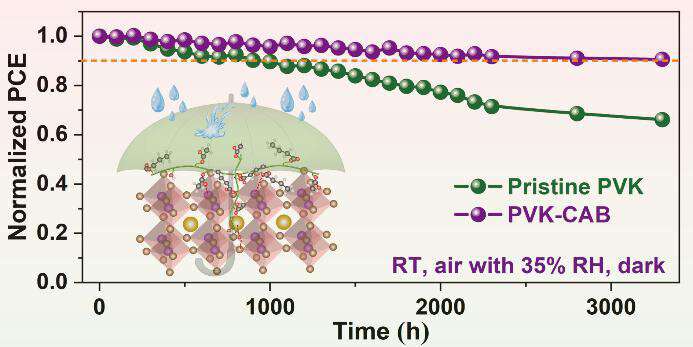Enhancing the stability of perovskite solar cells with a green and low-cost organic additive

Recently, Junyou Yang and Yubo Luo from the Huazhong University of Science and Technology, in collaboration with Xin Li from the National University of Singapore, published an article titled "Enhancing the stability of planar perovskite solar cells by green and inexpensive cellulose acetate butyrate" in Journal of Energy Chemistry.
Hybrid organic-inorganic halide perovskite materials are receiving considerable attention due to their high optical absorption coefficient, tunable bandgap, long carrier diffusion path, and solution processability, which enable low-cost mass production. In the last decade, single-junction perovskite solar cells (PSCs) have achieved a state-of-the-art power conversion efficiency (PCE) of 25.7% using regular (n-i-p) structures. However, the stability of PSCs still does not meet commercial standards.
The light-absorbing layer of PSCs is susceptible to irreversible degradation because of environmental conditions such as the humidity, oxygen content, ultraviolet (UV) illumination, electric field, and heat. The perovskite film primarily degrades due to the numerous defects therein, leading to nonradiative recombination in the device, and consequently, inferior device performance. Therefore, developing a high-quality perovskite with fewer defects that can facilitate carrier transportation at the interface between the perovskite and charge transport layer is of immense significance to enhance the efficiency and device stability.
A green and low-cost organic additive, cellulose acetate butyrate (CAB), was used to synthesize a high-quality perovskite thin film. The optimized perovskite film with significantly improved crystallinity demonstrated a nearly ten-fold-longer carrier lifetime than the pristine film. Furthermore, the energy level and stability of the optimized perovskite films were improved, leading to the fabrication of an optimized CAB-based device with a champion efficiency of 21.5% compared to the control device (18.2%). In addition, the optimized device could maintain an initial efficiency of more than 90% after aging for 3300 h at a relative humidity of 35%.
More information: Bo Xiao et al, Enhancing the stability of planar perovskite solar cells by green and inexpensive cellulose acetate butyrate, Journal of Energy Chemistry (2022). DOI: 10.1016/j.jechem.2022.09.039



















